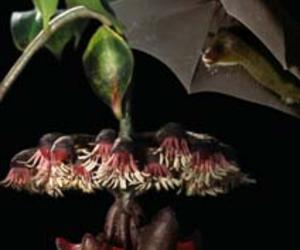Hear My Nectar! Dish-Shaped Leaves Attract Bats
- Submitted by: manso
- Society
- 07 / 29 / 2011

A vine beckons bat pollinators by emitting a strong acoustic echo that helps the bats find their nectar.By Jessica Marshall. Thu Jul 28, 2011 02:00 PM ET.
THE GIST :
* A vine from the forests of Cuba attracts pollinating bats using a dish shaped leaf that acts as an acoustic beacon.
* The shape of the leaf creates echoes so it stands out to echolocating bats.
* The structure halves the time it takes bats to find the food source and therefore pollinate the vines.
A photo montage show a flowering vesrion of Marcgravia evenia and an approaching Cuban nectar-feeding bat.Ralph Mangelsdorff and Ralph Simon
It's the acoustic version of a bright, showy flower: A Cuban vine attracts pollinating bats to its nectar not with color, but by posting a dish-shaped leaf over its flowers. The leaf reflects sounds in ways that draw the attention of echolocating bats, according research published today in Science.
The hemispherically shaped leaves halve the time it takes for bats to find nectar, compared to the flat leaves that line the rest of the vine, according to the researcher's experiments.
"That means that the flower will receive twice as many visits and the bat will take half as long to find the flower," said study author Marc Holderied of the University of Bristol, UK. "It's a win-win situation, really, just by displaying this special peculiarly shaped leaf in association with nectar."
"What is particularly amazing about this story is that it has so much analogy to pollination by visually oriented pollinators such as bees and birds. These visit flowers that are we are so familiar with, nice and colorful," Holderied said. "But color doesn't work at night in the rainforest and particularly it doesn't work for an echolocating pollinator."
The leaf acts like an acoustic beacon for the bats, creating intense echoes that sound the same from many directions. This makes them stand out from the rest of the plants in the bats' environment, including the vine's other leaves.
The researchers first saw the vine, Marcgravia evenia, in a natural history magazine. "When we saw this picture, it immediately struck us that evolution had been a step ahead of us again by using a hollow hemisphere reflector to attract bat pollinators," Holderied said.
The researchers began the process of going to Cuba, collecting the leaves and making accurate molds of them so that they could test the shape, independent of any scent or color cues, in attracting bats.
The team trained bats to look for food in tiny nectar feeders against a wall covered with a grid of model leaves. Sometimes they put the feeders behind a flat leaf, sometimes behind a curved leaf, and sometimes unassociated with a leaf.
They released a bat and timed how long it took to find the food source. A flat leaf did not help bats find the nectar faster, but the hemispheric leaf models halved the search time compared with no leaf or flat leaves.
"They used 'naive' bats that have never been exposed to these flowers or leaves previously, and the fact that these bats found them attractive shows it's not a previously learned behavior," noted Nathan Muchhala of the University of Nebraska, Lincoln.
"These are the nocturnal analog of bright leaves used to attract visually-oriented pollinators," he said.
Muchhala agrees, and the thinks they might be in the form of acoustically adapted petals. "Bat flowers tend to have thick, waxy petals that I'm sure have evolved to reflect echoes a certain way," he said.
"I'm absolutely certain we will find more amazing acoustic adaptation in floral signaling," Holderied concluded.
Source: http://news.discovery.com/earth/acoustic-leaves-bats-pollinators-110728....
Comments